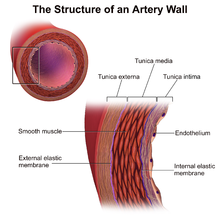Leukodiapedesis

Under a leukocyte extravasation (from ancient Greek διά dia , German , by, passing ' and πηδᾶν Pedanus , German , jump' ) refers to the passage of immune cells ( monocytes , macrophages , granulocytes , lymphocytes ) by the inner lining ( endothelium ) of the small blood vessels ( arterioles , Capillaries and venules ). With severe blood congestion, red blood cells ( erythrocytes ) can also escape. This form of cell passage is known as erythrodiapedesis .
Molecular Mechanism
As a result of inflammation , tissue macrophages and dendritic cells release cytokines . These are mediator substances that cause the endothelium of the blood vessels to react:
- Weibel-Palade bodies fuse with the cell membrane and present adhesion molecules ( selectin -P) on the surface (leukocyte adhesion).
- Selectin-E, CD31 and the integrins ICAM-1 and VCAM-1 are expressed with a time lag of a few minutes to hours.
- The endothelial cells contract and the dense cell-cell connections (zonulae occludens, " tight junctions ") dissolve. Usually these compounds prevent plasma from escaping into the connective tissue. The plasma can now escape and edema forms .
Monocytes and neutrophils normally circulate in the blood. However, they stick to the selectins (similar to an adhesive strip) and roll along the endothelium. This process is called rolling accordingly . With the integrins they form an even stronger bond, one speaks of an adhesion. Chemokines , especially interleukin -8, are expressed via the proteoglycans of the endothelium and activate the adherent immune cells. This leads to a change in a factor called LFA-1 (leukocyte functional antigen). The altered LFA-1 is now strongly binds to ICAM-1 and can via the actin - cytoskeleton activate the immune cell so that it begins with the leukocyte extravasation. For this purpose, elastases , proteases and hyaluronidases are released , which cut a hole in the basement membrane , which lies under the endothelial cells and destroys the connective tissue in order to find a way through. The immune cells migrate through this hole. They find their way to the point of inflammation along an IL-8 gradient.
Leukodiapedesis is a highly complex process in which communication between mediators outside leads to changes in the cell skeleton. The exact mechanism has not yet been clarified. Many intracellular proteins such as profilin , gelsolin , thymosin and actin play a role in this. The cells also have to protect themselves from their own catalytic enzymes. To do this, they carry receptors that, for example, bind elastase in a form that points the active center away from the cell membrane.
literature
- Charles Janeway , Paul Travers, Mark Walport, Mark Shlomchik: Immunology. 5th edition, Spektrum Akademischer Verlag, Heidelberg 2002, ISBN 3-8274-1079-7 ; Online version in English , 5th edition, 2001.
